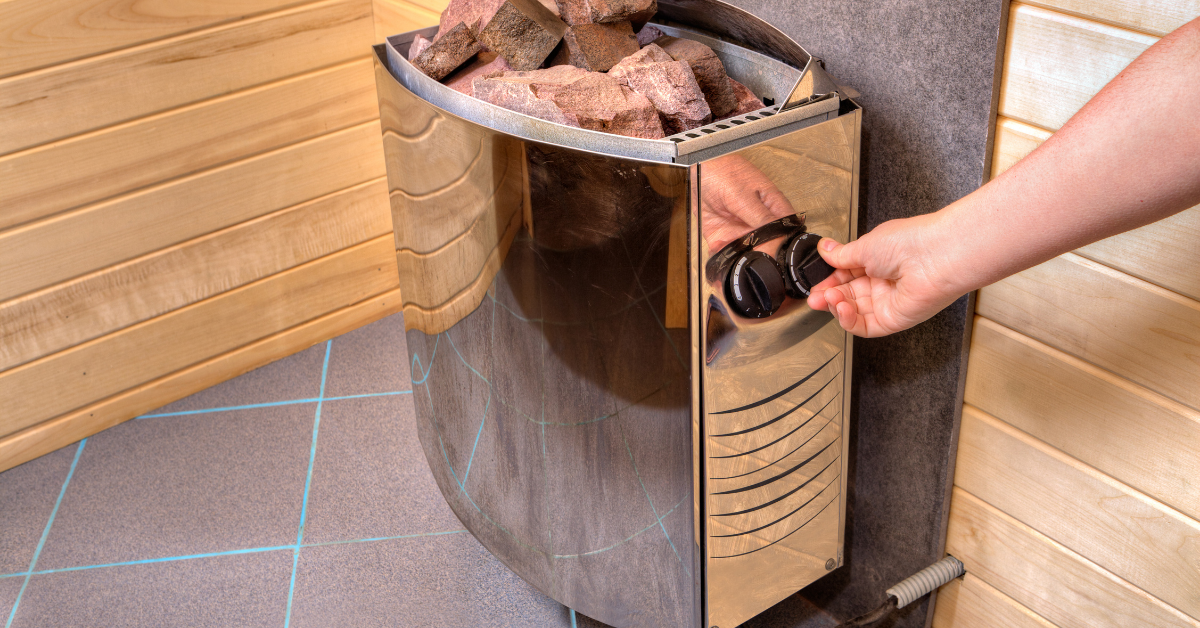Saunas and steam rooms are two popular types of heat therapy that offer a variety of health benefits. While they share some similarities, there are key differences between the dry heat of a sauna and the moist heat of a steam room. Understanding how they work can help you decide which may be better for your health goals.
How Saunas Work

Traditional saunas use dry heat, typically between 150-200°F, to make you sweat and raise your core body temperature. Heating elements like electric heaters or hot rocks warm the ambient air temperature while you sit inside the sauna room. As your body heats up, blood vessels dilate, increasing blood flow. Sweating helps cool your body and removes toxins from the skin. Sessions usually last 10-20 minutes and are followed by a cool-down period.
Infrared saunas work a bit differently. They use infrared light waves to penetrate the skin and heat the body directly, with temperatures ranging from 100-150°F. Lower temperatures allow longer sessions of up to 30 minutes. The direct heat increases blood flow, induces sweating, and provides deep tissue heating.
Hybrid saunas offer the best of both worlds, providing the option of choosing between traditional and infrared.
Airpuria offers a wide selection of traditional and infrared saunas to fit any space. Indoor and outdoor sauna options are available, including portable one-person saunas up to spacious 8 person saunas. Top brands like Sunray, Enlighten, and Dundalk are proud to partner with Airpuria.
How Steam Rooms Work

Steam rooms provide moist heat through the inhalation of warm, humid steam. Steam is generated by pouring water over heated rocks or using a steam generator with boiling water. Steam room temperatures are typically around 110-114°F with nearly 100% humidity.
Sessions usually last 10-15 minutes as the humid air heats the body. The ambient air temperature is lower than in a sauna, but steam rooms make you sweat more profusely due to the humidity. This moist heat penetrates the skin and nasal passages differently than dry heat.
Comparing the Health Benefits

Saunas and steam rooms both offer heat therapy benefits, but the type of heat impacts the body in different ways. Understanding the unique benefits can help you choose the best option to support your health goals.
Cardiovascular Health
The intense heat from saunas raises your heart rate, similar to cardiovascular exercise. A review in Complementary Therapies in Medicine found sauna bathing improves heart health, including reduced blood pressure and arterial stiffness. Infrared sauna use specifically may also improve vascular function.
The atmosphere of a steam room session can offer some cardiovascular advantages, although these may not be as pronounced as those gained from using a sauna.
Muscle Relaxation and Pain Relief
The direct heat penetration of infrared saunas can help muscles recover after exercise and ease discomfort or stiffness from conditions like arthritis. In addition, infrared sauna sessions have even shown improvements in symptoms of chronic fatigue syndrome.
Detoxification
Sweating in a sauna or steam room aids in the body's detoxification process, helping to expel toxins. It's worth noting that saunas might be particularly effective in removing environmental chemicals, including toxic metals, through sweat. In addition, the use of infrared wavelengths in these settings could contribute to a targeted release of toxins.
Stress Relief and Mental Health
The relaxation and meditative properties of both sauna and steam bathing are conducive to promoting mental health. Sauna sessions are known to reduce stress and offer psychophysiological benefits.
Similarly, using a steam room has been associated with reductions in anxiety, tension, anger, confusion, and depression.
Weight Loss and Body Fat Percentage
Saunas create high temperatures that encourage heavy sweating and can result in increased calorie expenditure when paired with other activities (such as post-exercise). Many people think that the weight loss from sauna use is primarily due to the loss of water weight. However, since sauna bathing can simulate cardiovascular exercise, it can also contribute to fat loss in the right circumstances. Although further research is required to determine exact numbers, some scientists have discovered a burst of natural HGH (human growth hormone) production when sauna bathing during post-workout recovery.
Regular steam room usage does not lead to substantial weight loss. However, it's interesting to note that regular steam room sessions could contribute to losing water weight, suggesting a potential complement to a fitness routine.
Finding the Right Option for You

Both the sauna and steam room provide therapeutic benefits through dry and moist heat therapy. Traditional saunas, especially frequent use, may offer more cardiovascular and detoxification benefits, whereas infrared saunas also provide targeted heating. On the other hand, steam rooms are gentler and offer direct moist heat for the skin, nasal passage, muscles, and joints.
Consider your health goals, any conditions you want to improve, and your personal preference between dry and wet heat therapy. A sauna may fit your needs if you prioritize heart health, detoxification, and muscle pain relief while steam rooms are great for relaxation, skin health, stiff joints, and congestion relief. In addition, many people also enjoy the aromatherapy benefits of a steam room.
It is important to note that most of the benefits of steam room sessions, such as aromatherapy, can be easily added to your sauna experience - making the sauna the ideal choice overall.
Ready to explore your options? Browse Airpuria's wide selection of traditional, infrared, and hybrid saunas to find the perfect fit. Reach out with any questions!
Additional Health Considerations
While saunas and steam rooms are generally safe for healthy individuals, it's important to consider any underlying health conditions or risks before use. Here are some additional factors to keep in mind:
Pregnancy and Children
It's best for pregnant women to avoid using saunas or steam rooms. Similarly, children under 6 years old should steer clear of these heated environments to prevent the risk of overheating. Consult with a physician or pediatrician before letting your child into the sauna if they are between the ages of 6 and 18. It is always recommended to accompany children under 18 in the sauna.
Uncontrolled Blood Pressure
For those with uncontrolled high blood pressure or unstable cardiovascular conditions, consulting a doctor before regular use is advisable. The abrupt heat exposure could potentially lead to spikes in blood pressure. Similarly, individuals with low blood pressure may also encounter symptoms that warrant consideration.
Respiratory Conditions
The hot, humid air of a steam room or steamy sauna may worsen respiratory conditions like asthma, bronchitis, or COPD for some individuals. However, the moist heat may also help open nasal passages and provide relief in some cases. It is best to consult your doctor for the most personalized advice.
Tips for Using Saunas and Steam Rooms Safely

While saunas and steam rooms offer therapeutic benefits, it’s crucial to keep safety in mind, especially when getting started. Follow these tips for safe usage:
-
Hydrate well before and after - Drink at least 16 oz. of water before entering and replace fluids lost from sweating afterward. Avoid alcohol, caffeine, or diuretics prior.
-
Start low and slow - Begin with sessions of just 5-10 minutes and slowly work up to 15-20 minute maximums. Give your body time to adapt to the heat.
-
Cool off between sessions - Allow your body temperature to fully normalize between back-to-back sauna or steam room use. Rest 10-15 minutes between sessions.
-
Look for signs of heat exhaustion - Symptoms like headache, nausea, dizziness or excessive sweating are signals to stop sessions immediately.
-
Shower first - Rinse off before using saunas or steam rooms to allow your body temperature to start lower.
-
Watch medications and health conditions - Check with your doctor about any interactions or precautions needed for medications or pre-existing health conditions.
-
Avoid eating just before - Allow 1-2 hours after meals before heat therapy to prevent nausea.
-
Listen to your body - Pain, burning sensations, or general discomfort means it’s time to end your session. Don’t push past your limits.
-
Use a towel - Sit on a towel to absorb sweat and keep benches hygienic for others.
-
Keep sessions under 30 minutes - Limit traditional sauna time to 15-20 minutes max and infrared to 30 minutes to prevent overheating.
-
Check heat settings - Ensure traditional sauna temperatures stay under 200°F and infrared under 150°F.
-
Skip the sauna if you’re sick - Hold off on sauna and steam room use if you have a fever, infection, or are otherwise ill.
Proper hydration, pacing yourself, and listening to your body help ensure safe heat therapy sessions. Be sure to review all instructions for your specific sauna or steam room model as well. If ever concerned, consult your doctor before getting started.
Finding the Right Balance Between Sauna and Steam

Some enjoy alternating between saunas and steam rooms to experience the unique benefits of dry and wet heat therapy. Keep these tips in mind:
-
Allow your body to fully cool down between sessions
-
Start with just 5-10 minutes in each room and slowly increase the time
-
Hydrate well between rooms to replace fluids lost from sweating
-
Listen to your body and take a break if you feel overheated at any time
Balancing time between saunas and steam rooms allows you to experience both deep heating and moist heat relaxation.
Sauna VS Steam Rooms FAQ
What is more beneficial sauna or steam room?
Both saunas and steam rooms offer health benefits, but saunas may have more research showing cardiovascular improvements and detoxification from frequent use. Steam rooms can provide therapeutic moist heat for muscle relaxation and breathing benefits. Regularly alternating between the two types of heat therapy allows you to experience the advantages of each. If you have to choose one, we recommend choosing the sauna for more all-encompassing benefits.
Which is better steam room or dry sauna?
Saunas are an overall better choice for all-encompassing therapeutic benefits and features. Many of the benefits of a steam room can be easily applied to sauna usage depending on which accessories one decides to add to their home sauna.
Is sauna or steam room good for health?
Yes, both saunas and steam rooms offer numerous health benefits. Saunas improve cardiovascular function, relieve pain, and aid detoxification. Steam rooms also provide pain relief in addition to nasal passage and skin hydration in the form of wet heat therapy, which can impact some people differently.
Contact Us for Your Home Sauna

If you are ready to embark on the dry heat journey of health and longevity, it's time to contact Airpuria. As a proud authorized dealer of world-renowned brands, Airpuria offers a wide selection of saunas from trusted brands to transform your home into a relaxing oasis of wellness.
Contact us to learn more and find your perfect heat therapy escape:
Phone: 773.337.8822
Email: sales@airpuria.com
Finance Your Home Sauna
-
For individuals, Airpuria offers financing for those who qualify with rates as low as 0% for up to 18 months. This allows you to spread out the cost over time with low or no interest. Learn more and check your rate at https://www.7figures.app/Airpuria.
-
For businesses, Airpuria provides flexible financing terms tailored to your company's needs. With competitive rates and financing options from 6 to 84 months, investing in a home sauna is easier for any budget. Explore business financing options at https://reliantcapitalgrp.com/airpuria.
Contact the Airpuria team to learn more about our financing solutions. Investing in a sauna can pay dividends for your health, relaxation, and overall well-being.
Note: All saunas and heaters purchased at Airpuria come with a warranty.

